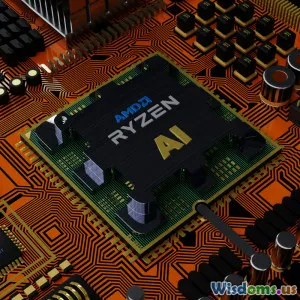
Should You Use Rust for High Performance Embedded Systems
9 min read Explore if Rust is the right fit for high-performance embedded systems, balancing safety, speed, and reliability. (0 Reviews)
Should You Use Rust for High Performance Embedded Systems?
In the world of embedded systems—where every byte and cycle counts—choosing the right programming language can make or break your project. Traditionally dominated by C and C++, this domain is witnessing the rise of Rust, a systems programming language known for its safety guarantees and impressive performance. But is Rust truly ready to handle the rigors of high-performance embedded systems, or is it just a passing trend? This comprehensive dive explores the merits and challenges of adopting Rust in embedded environments.
Understanding High-Performance Embedded Systems
Before delving into Rust, let's clarify what we mean by "high-performance embedded systems." These are specialized computing devices embedded within larger mechanical or electrical systems, designed to perform dedicated functions with stringent timing or resource constraints.
Examples include:
- Aerospace control modules where timing and reliability are mission-critical.
- Automotive engine control units (ECUs) requiring real-time responsiveness.
- Industrial automation controllers that must operate safely under extreme conditions.
Such systems demand not only peak performance but also absolute safety and deterministic behavior, often with minimal hardware resources.
Why Language Choice Matters in Embedded Systems
The programming language affects:
- Performance: How fast and efficiently code executes.
- Memory Footprint: Embedded systems often have strict limits on RAM and storage.
- Reliability and Safety: Bugs in embedded software can lead to catastrophic failures.
- Toolchain Support: Availability of compilers, debuggers, and other development tools.
C and C++ have long been staples because they allow fine-grained hardware control and generate efficient machine code. But drawbacks like manual memory management and undefined behavior pose significant risks.
Introducing Rust: What Makes It Attractive?
Rust emerged to bridge the gap between high-level convenience and low-level control.
Key features include:
- Memory Safety Without Garbage Collection: Through ownership, borrowing, and lifetime rules enforced at compile time.
- Zero-cost Abstractions: Safety features without runtime overhead.
- Concurrency Safety: Data races are caught at compile time, which is crucial for embedded systems that often leverage multi-threading.
Rust’s growing ecosystem—including the embedded-hal (Hardware Abstraction Layer) and real-time support libraries—signals its rising maturity in embedded contexts.
Rust in Embedded Systems: Advantages
1. Safety Without Compromise
Unlike C/C++, Rust prevents common programming errors like buffer overflows, null pointer dereferencing, and data races by design.
Example: NASA's Jet Propulsion Laboratory has expressed interest in Rust to enhance safety-critical software reliability, a testament to the language's promise in extreme environments.
2. Performance Comparable to C
Rust code typically compiles down to efficient machine code. By enforcing safety at compile time rather than runtime, there's no garbage collector pause, and developers can write no_std programs (avoiding the Rust standard library) to reduce dependency on OS features.
Benchmarks show Rust matching or surpassing C in certain numeric and system-level computations, making it suitable for timing-critical tasks.
3. Rich Modern Tooling
Rust’s tooling improves developer efficiency:
- The
cargobuild system simplifies dependency management and builds. - Clippy lints catch common mistakes early.
- Rustfmt auto-formats code to maintain consistency.
This reduces development time and lowers the bug rate compared to the fragmented C toolchain.
4. Growing Community and Ecosystem
Embedded Rust’s community has surged, creating libraries for microcontrollers like STM32, ESP32, and RISC-V.
Projects like Drone OS (an open-source drone control platform) utilize Rust to achieve reliable, maintainable systems.
Challenges of Using Rust for Embedded Development
1. Steeper Learning Curve
Rust’s ownership model, while powerful, can be challenging for developers experienced in more permissive languages.
Embedded programmers must adapt to Rust’s strict compile-time checks, potentially increasing initial development time.
2. Immature Ecosystem in Some Areas
Although growing quickly, Rust’s embedded libraries sometimes lack the breadth and polish of legacy C libraries.
Certain hardware peripherals or very niche platforms may not yet have Rust support.
3. Runtime Constraints
For extremely resource-constrained devices (like those with kilobytes of RAM or non-existent OS support), integrating Rust can require careful configuration and custom linker scripts.
4. Debugger and Toolchain Limitations
While improving, debugging Rust embedded applications can be less straightforward than C.
Standard embedded debuggers (JTAG, SWD) are compatible, but higher-level Rust-specific tooling is still evolving.
Real-World Case Studies
Tock OS: Safe IoT Operating System
Tock is an embedded OS written in Rust targeting IoT devices. It leverages Rust’s safety and concurrency to sandbox applications, improving resilience against system failures.
This opens pathways for secure connected devices in smart homes and healthcare.
Amazon Firecracker
While not embedded in the traditional sense, Firecracker is a lightweight virtualization manager written in Rust, illustrating Rust’s capability to handle low-level, highly performant, and secure computing.
Its design principles carry over to embedded security-focused projects.
When Should You Use Rust?
-
Choosing Rust is ideal if:
- Safety and concurrency are top priorities.
- Your device has moderate resources allowing
no_stdRust execution. - You seek modern tooling to reduce development cycles.
- You are building new hardware or software where leveraging Rust from the start is feasible.
-
Consider sticking with C or C++ if:
- Your project targets ultra-constrained hardware below Rust ecosystem support.
- Existing codebases and tooling investments in C/C++ are too large to switch.
- Developer familiarity and rapid prototyping in legacy languages are paramount.
How to Get Started with Rust Embedded
- Set Up the Toolchain: Install Rust with embedded support via
rustup, choosing appropriate targets (e.g., thumbv7em-none-eabihf for ARM Cortex-M4). - Use
no_std: Develop without Rust’s standard library, which is not typically available on microcontrollers. - Leverage Crates: Explore essential crates like
embedded-hal,cortex-m, andrticfor real-time concurrency. - Community Resources: Join forums like the Rust Embedded Working Group and tutorials to accelerate learning.
Conclusion
Rust presents a compelling option for high-performance embedded systems through its unique coupling of speed, safety, and modern developer ergonomics. While not yet universal across all embedded niches, its rapid ecosystem growth and use by leading-edge projects showcase enormous potential.
For teams ready to embrace its paradigms, Rust can minimize elusive bugs like memory-related faults, improve concurrency guarantees, and maintain performance equivalent to traditional languages—all crucial in embedded system success.
So, should you use Rust for high-performance embedded systems? If safety, reliability, and future-proofing are on your priority list, Rust not only merits serious consideration but also offers rewarding returns.
Why not dive in and explore Rust’s embedded ecosystem yourself?
References
- Rust Embedded Working Group
- NASA’s Interest in Rust for Space Missions
- Palmer, T. (2020). Embedded Rust – Safety in Embedded Systems, IEEE Spectrum.
- Tock OS Project
- Firecracker Github Repository: https://github.com/firecracker-microvm/firecracker
Author’s Note: Always evaluate project requirements, resource constraints, and team expertise before your language choice. Rust is a powerful tool—but like all tools, best applied in its ideal niche.
Rate the Post
User Reviews
Popular Posts




















